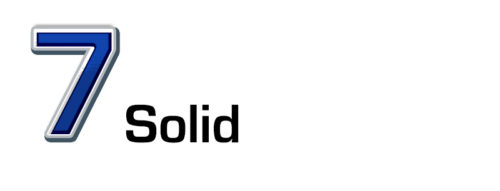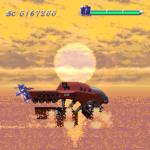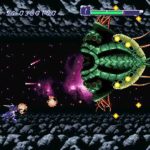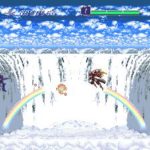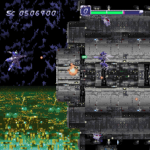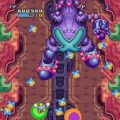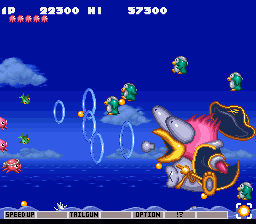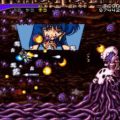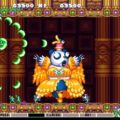Developer: Micronics Publisher: Naxat Soft Released: July 26, 1996 Genre: Shooter
Spriggan Powered is a game that I discovered through the magic of emulation. While I devoured any and all gaming publications growing up they could only cover so much. Without emulation and the internet I would never have discovered and bought many late generation titles such as Renny Blaster, King of Demons, and this hidden gem. The majority of the Super Nintendo’s better shooters all reside in Japan and this is one of them. When compared to the systems best it ranks as a solid game but is still far better than crap like D-Force and Strike Gunner STG.
The weapon selection available is pretty light which I am not a fan of. Random enemies drop color cycling orbs that correspond to four weapons, each with a weakness. The red machine gun has a nice spread pattern and rate of fire but has a narrow radius. The green homing shot tracks enemies but is incredibly weak and not worth using. It is even worse as it causes unnecessary slowdown. The blue laser creates a satellite that apes your movements. It isn’t exceptional, it’s just…there. The only decent weapon is the orange fireball that explodes on impact.
Where the weapons come up the shield meter almost makes up for it. With your power meter you can call up a shield at any time that protects you from nearly anything. Bullets, head on collisions, and even crushing environments can be circumvented with your shield. A quick tap only uses it slightly but a continual press drains an entire slab. More importantly the shield can charge up a more powerful version of your current weapon. Two of the less impressive weapons become dramatically overpowered this way. The laser actually slows down time while the homing orbs create four massive orbs that linger and cause damage over time. The game isn’t shy about refilling the meter either, allowing you to use it semi frequently.
Spriggan Powered is a faster paced shooter than most SNES games. Enemies appear in densely populated groups and your mech presents a large target. Despite that the game incentivizes purposely navigating through enemies by granting a tech bonus. The closer you come to death the more it procs, allowing you to rack up the points. Very few games make use of this mechanic and the risk/reward nature of it helps the game exciting. At six levels this isn’t a long game but it is plenty entertaining with its frequent boss encounters and constant action.
You are limited to two credits but despite that Spriggan Powered is about average in difficulty. New weapons appear on a regular basis, allowing you to experiment as the situation dictates. Even if you die you have a small window to recollect your power-up. The tech bonus from straying close to enemies and their fire is key to rack up points for extra lives as well. It has its choke points, notably stage four and its limited field of view and the entire last stage. But shooter novices will be able to conquer this beast with moderate difficulty.
At the time of its release in 1996 Spriggan Powered looked amazing. While most of its pre-rendered sprites are small the bosses are large mechanical ships that often undergo multiple transformations. There are all kinds of details that make the larger ships that much more impressive such as specular highlighting to give them a nice sheen. The true star of the presentation is the backgrounds which are drop dead gorgeous. Mode 7 is employed in subtle ways that isn’t gratuitous and adds to the atmosphere as well.
The overly dark intro and box art are in stark contrast to the game’s actual presentation. Overall this is a pretty bright game as you fly over sparkling waterfalls (complete with rainbows), rolling forests, and a bout among the clouds at sunset. Compared to the dull metal cityscapes of most games in the genre this is a breath of fresh air, even more so since most pre-rendered games of that era were incredibly dark due to the limited color palettes of the 16-bit consoles.
There is a cost for all this visual splendor however. The game has some truly awful slowdown in spots. It isn’t frequent which is why the isolated incidents when it occurs stand out. In tight corridors it is fine as the screen is often full with bullets. In wide open fields the game can slow to a crawl. By 1996 most SNES shooters had this problem solved. Too bad the developers did not show restraint in order to maintain performance.
In Closing
Aside from that Spriggan Powered is a solid shooter. It isn’t as varied as its lavish production values would suggest but still makes for an entertaining afternoon. Sadly it has never been re-released and so goes for a high price. There are better SNES import shooters to choose before tracking this one down no matter how solid it is.
